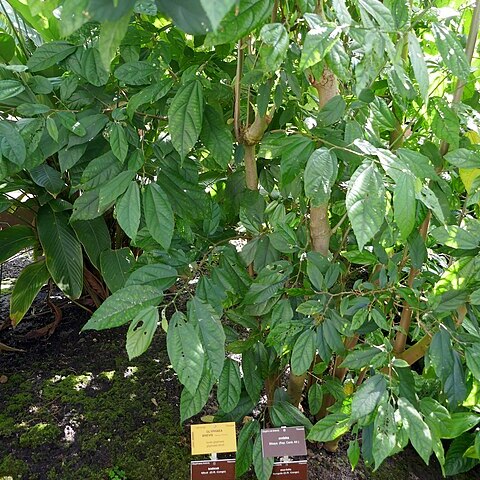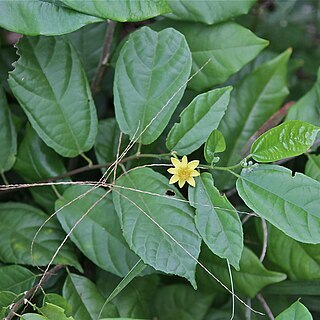Shrub or tree 1.5–20 m tall, often straggling; branchlets sparsely stellate-puberulous, later glabrous.. Leaves ovate, obovate, obovate-lanceolate or oblong to elliptic, 5–25 cm long, 1.5–14 cm wide, long-acuminate at the apex, the acumen up to 3 cm long, rounded to subcordate at the base, subentire or doubly-toothed, thin, nearly glabrous or sparsely puberulous on the venation above, adpressed puberulousbeneath, often with 2 sorts of stellate hairs; lateral nerves in 5–7 pairs with the 2 basal reaching over half way up the blade or beyond; stipules lanceolate, ± 2 mm long, very deciduous; petiole 1.5–3.5 cm long.. Peduncles 0.5–2 cm long.. Pedicels 1–2.5(–3.3) cm long.. Flowers up to 4.5 cm in diameter; sepals green, yellow inside, oblong, 1.5–2 cm long, 0.3–0.5 cm wide, tomentellous outside; petals golden or lemon-yellow, oblanceolate or narrowly oblong, 1–2 cm long, 4–4.2 mm wide; stamens yellow; style 6 mm long; stigma green.. Fruit brown, spindle-shaped, 3.5–7.6 cm long, 1.2–1.6 cm wide, ridged and beaked.. Seeds irregularly ellipsoid, 4 mm long, 3 mm wide, wrinkled when dry.. Fig. 17.
More
A shrub or small tree. It grows 3-6 m tall. The bark is grey-brown. The small branches have hairs when young. The leaves are 5-30 cm long by 2-11 cm wide. The leaves usually droop. They are oblong and rounded at the base. There are normally small teeth along the edge. The leaf stalk is 5-30 mm long. The flowers are yellow. The flowers are in a head near the ends of branches. These are 2.5-3.5 cm across. The fruit are like a woody okra fruit. The fruit are spindle shaped and grooved. They are 4-7 cm long and 10-15 mm wide.



